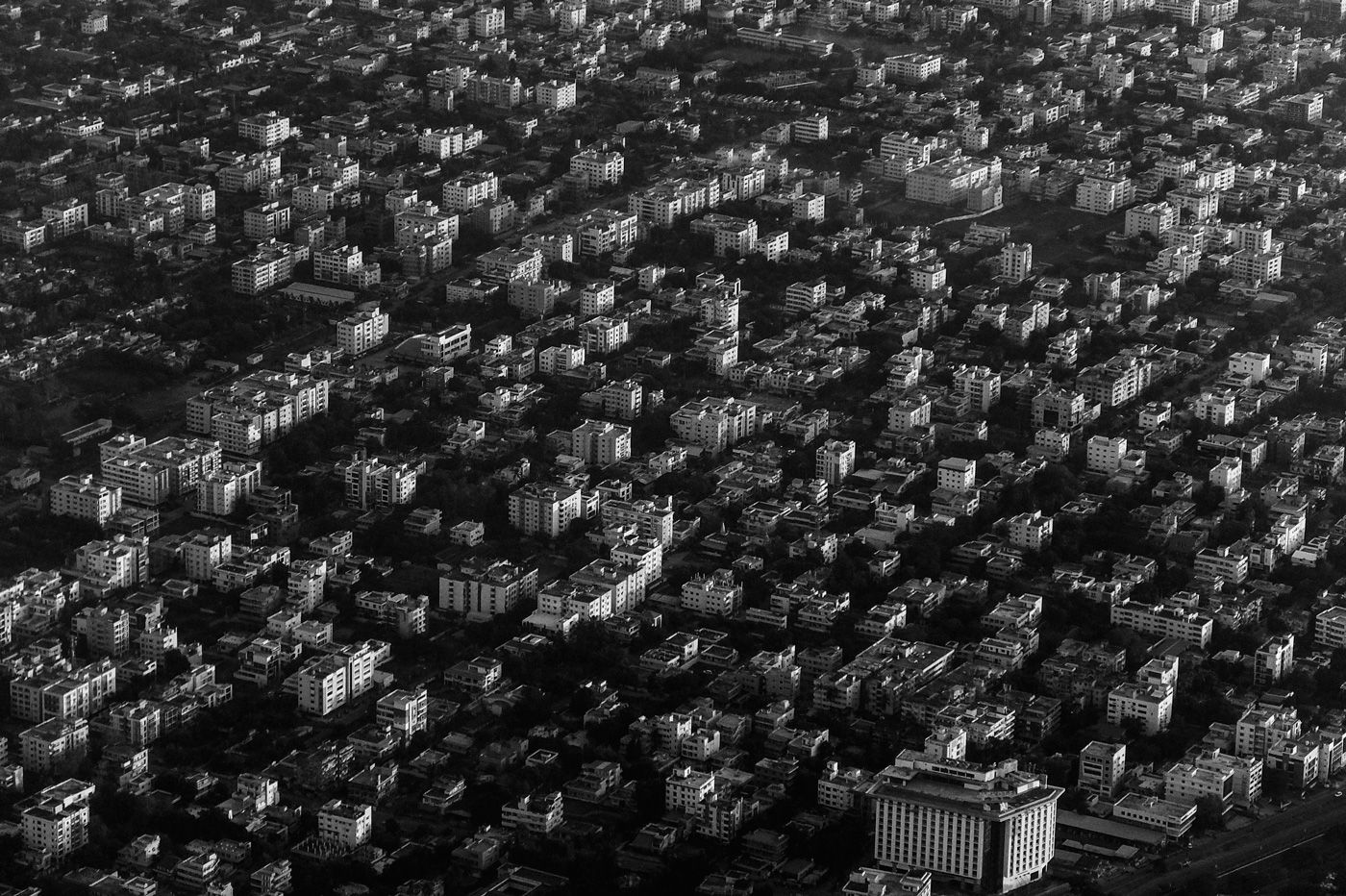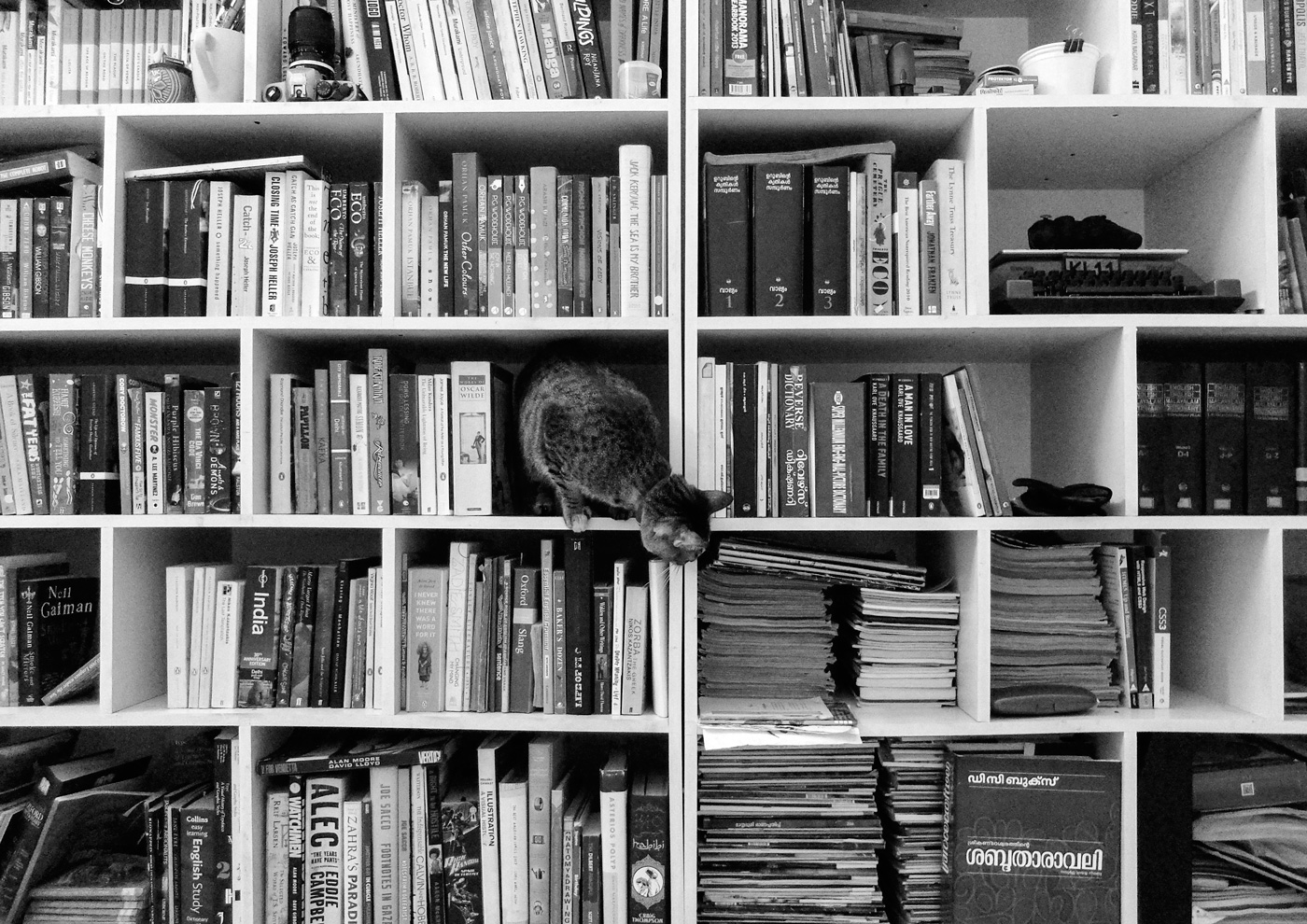Bus Stops and Cake
→ November 11, 2018 | Reading time: 10 minutes | Permalink
The landscape presents itself differently when you are standing in a bus (to Vijayawada this time); the ditches that seem to hug the road otherwise turn out to be rivulets a stone’s unexcited throw away (and towards the city, yellow LED lights line the otherwise shapelesss water); the acacia plantation appears grounded not far below the highway; the lively first-floor rooms are less enticing to peer into over their now displaced sense of privacy; the potholes and too frequent speed bumps feel more immediate to the spine as the grab-pole rubs against you in calculated thrusts of mild indignation.
The bus looks empty from the outside, observed head on, and I get in to a sea of sitting bodies on the floor and shopping bags of the thick-and-well-worn variety (not the fresh-off-the-supermarket variety; these ooze character) in various states of disagreement with their owners and the floor. My knack (thanks to the road curving outwards to meet the bus stop across from home) for being able to tell how full the bus is from the outside doesn’t help when the people retreat to using the floor for what it is. The lady conductor is annoyed there are too many passengers going too many places along the way. The bus has to stop before it can reach a respectable speed on the highway, with all the speedbumps and people getting out at stops they mistake for their own. Small arguments materialise as the people who mistakenly get out defend their choices and the people inside launch small lessons in geography and road construction. The bus sticks to service lanes dodging the occasional cow (and later, three dogs facing away and oblivious to evening traffic). The driver is a man who has seen enough; he doesn’t honk anymore, at the cows or the three dogs. During an argument (not the mistaken bus stops one, but a different one about state transport buses not stopping where they should) he keeps looking to the left at the man aglow in righteous anger and pays no attention to the road in front. There is a moment of panic as the bus veers into the dusty footpath, while a quick flick of the driver’s wrist sends it back up against oncoming traffic. He looks forty; the lady conductor maybe older by a year or five. He’s switched off the low-floor bus’s modern contraptions and a touchscreen hangs dead to his left. The lady conductor is always angry, and has a yellow malli tucked into her hair shaped into an awkward pretzel with an air of being messed with too many times. She folds the notes lengthwise and holds them between her fingers the way private bus conductors do. She resembles a Geisha in her oversized coat over a floral print polyester saree and the folded notes swatting at an invisible fly like an unfurled fan. I don’t share the image with her for fear of being yelled at in Telugu. Telugu at rest sounds like it is going a thousand kilometers an hour; you can’t tell if the people yelling at you are in fact, being polite. Of the bunch of University students that get in at the next stop, a girl in a tie-on niqab eases into a rehearsed texting position along the shopping-bag-laden aisle. She handles the holding-onto-seats-while-keyboard-pecking act admirably well as the older lady sitting sideways on the seat in front stares with what I take to be a sense of worn time. As always, I am more concerned whether the texts are well punctuated, capitalised and if the ellipses are true ellipses. She (not the niqab girl; the old lady) smiles as our eyes meet at yet another unplanned stop and people rearrange themselves and their bags and their drooping children to acknowledge the newly empty seats. We reach Vijayawada in an hour that seems to pass with no more mistaken exits. As we pass the compound walls decorated in flowers (in different stages of undress, if that is possible) and the city wakes up into the evening, the bus conductor looks relieved and the niqab reunites with her friend who had scored a seat early on. The friend wears a pissed off face and rimless spectacles in place of a head dress. I think the head dress could have traded places.
The bus station reads nothing like a destination. People are in flux. Even when they are eating from the many stalls that make the bus stand, they seem to be holding a ticket to somewhere. The stalls don’t look like permanent structures either. Some essential grounding element is missing in the way their walls meet the tiled floor at strict right angles. I wonder if improperly brutalist buildings look restless too. I wonder if there is a direct bus to Chandigarh.
Baker’s Inn is (as it seems the right—the only—way to be) tucked away into a lot right after the Paradise Biryani building. I vow not to look up a bookshop on the ill-behaving Maps application. For a change, I let biryani sit higher in the checklist as I retrace (the ten) steps to Paradise. The store is empty but for two tables and IT people at the counter, waiting for their take-away orders to turn up. The menu is tilted to favour real biryani aesthetes and not the grass-and-peas ones.
I wish, for the three hundred and twenty seventh time, there was a half-plate option for people who prefer the fine-dining-walk-of-shame-from-the-counter alone. (It is degrading for the same reason it is easy to find a seat in a packed restaurant when you go in as a party of one; the management is happy to fill tables if that means more money and less conversations. Then there is the original thing with two-plate dinners disguised as single, full-plates.) This restaurant is near empty and disorienting; in its airportly odorless-ness. I pick the corner-most seat. A helpful cutaway diagram in a McDonaldesque printed sheet below the kadhai boasts extralong basmati rice and extrarich masala and a Biryani Club membership ad promises a free one down the line. (I imagine that one to be a slippery slope or a very thin line if at all, as I fiddle with the sides and a dearth of spoons. I eat with my hands. [Not that nobody else does; I just don’t use the cutlery for transportation.]) The well at my father’s place is dug like a giant, condensed L. The bottom caves in to (Under? Below? Imagine a huge, solid, rounded L of emptiness.) where one stands to draw water from, and one can’t really see into it as far as one would like to. I proceed to recreate that well in the biryani pot, avoiding the extralong rice for the (three; 3) pieces of paneer and many pieces of carrots impersonating more pieces of paneer. (I must say one of the three [3] pieces was more of a slab by biryani-pot standards. But I digress.) Tiny insects (about the size [and consistency, and taste] of a cumin seed) nosedive into the leftover rice and I can’t tell if they are used to this. The badges just say PROBIRYANIDIVETEAM. The insect-garnished food releases a nice biryani-smell as I bring handfuls closer to my noggin, not like fake-biryani at all. I wonder if the IT regulars at the counter had something to do with the aroma-late-release mechanism. The hara bhara kebabs (all nine [9] single-person-shaming pieces) taste tired, in an appropriate way. I wish I had the blue Tupperware lunchbox with me. I am sevety-nine percent certain, that along with the towel, a Tupperware lunchbox is one of those things you can’t afford to get out of the galaxy without. I attempt reading some fairgrounds-reporting as I eat and it doesn’t work out the way it used to. The food demands attention (with the kamikaze cumin seeds and whatnot) and the chain-restaurant ambience makes me focus more on the spices in an attempt at savouring it despite.
Baker’s Inn is equally lovely for its lack of patrons at this hour. The portions are surprisingly one-man-friendly for the Valentine’s day ambience. There are no (0) fake flowers in sight. I order a Rich Truffle pastry to go with the coffee. It turns out to be sweet enough for a table of four. (I don’t mind.) The coffee drips from a swanky CCD-branded machine and sets expectations right. Not a lot happens over it. The paper cup has pink butterflies and random basic shapes on it. This I hate.[1]
I take a different road back to the bus station and am glad I did. As I get off the auto onto the loud and in-flux bus station premises, Mr. D calls up to say Dekho is in a design history book now. He wants to know if I am happy. Maybe the news hasn’t sunk in enough to make me sound cheerful. I manage to ask after the studio people before the buses and people going places are too unbearable to be talking on the phone. I text him with a promise to eat more cake if that helps bring more good news. He says I should, everyday. Design history books are expensive business. Having something you helped make printed in one of them is supposed to be a big deal first, and a soft-but-heavy cross to bear, next. I skip the big deal bit and find a Guntur bus. I look at the cropped-and-saved Guntur Talkies poster to double check if the bus is really Guntur-bound. The conductor confirms this and seems to be less on edge than the last one. I think this one is married to the driver. There is something very domestic in the way she hands him the one-liter ex-Sprite bottle. A frail young man is sleeping on the 3-seater bench ahead of where I sprawl. He is asked to leave at the first stop. He doesn’t look surprised at the request and is relieved the demand came early. He plays a fixed, recurring part in the domestic scene, judging from the way all three parties take the whole deal in with an unstated-kind-of-compliance. The bus is a home on wheels at night. All scenes turn domestic past the hour a city sleeps. This is why it is wise to stay on the streets after the shuttered shops have shut and the last of the hundred-rupees-no-bargains-pajama-vendors have gone home. The bus is empty and jumpy on the speedbumps. The conductor breaks into a song and the bus is now a cradle. She doesn’t have a malli tucked into her perfect hair.
1: With the appropriate intensity expected of a man on a biryani-then-sugar high.


